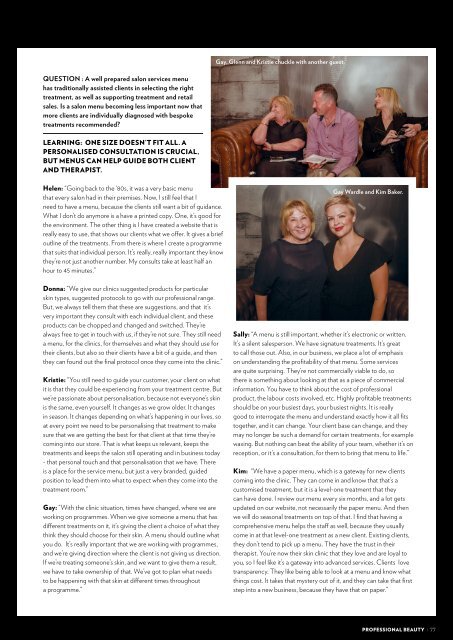Create successful ePaper yourself
Turn your PDF publications into a flip-book with our unique Google optimized e-Paper software.
Gay, Glenn and Kristie chuckle with another guest.<br />
QUESTION : A well prepared salon services menu<br />
has traditionally assisted clients in selecting the right<br />
treatment, as well as supporting treatment and retail<br />
sales. Is a salon menu becoming less important now that<br />
more clients are individually diagnosed with bespoke<br />
treatments recommended?<br />
LEARNING: ONE SIZE DOESN’T FIT ALL. A<br />
PERSONALISED CONSULTATION IS CRUCIAL,<br />
BUT MENUS CAN HELP GUIDE BOTH CLIENT<br />
AND THERAPIST.<br />
Helen: “Going back to the ‘80s, it was a very basic menu<br />
that every salon had in their premises. Now, I still feel that I<br />
need to have a menu, because the clients still want a bit of guidance.<br />
What I don’t do anymore is a have a printed copy. One, it’s good for<br />
the environment. The other thing is I have created a website that is<br />
really easy to use, that shows our clients what we offer. It gives a brief<br />
outline of the treatments. From there is where I create a programme<br />
that suits that individual person. It’s really, really important they know<br />
they’re not just another number. My consults take at least half an<br />
hour to 45 minutes.”<br />
Donna: “We give our clinics suggested products for particular<br />
skin types, suggested protocols to go with our professional range.<br />
But, we always tell them that these are suggestions, and that it’s<br />
very important they consult with each individual client, and these<br />
products can be chopped and changed and switched. They’re<br />
always free to get in touch with us, if they’re not sure. They still need<br />
a menu, for the clinics, for themselves and what they should use for<br />
their clients, but also so their clients have a bit of a guide, and then<br />
they can found out the final protocol once they come into the clinic.”<br />
Kristie: “You still need to guide your customer, your client on what<br />
it is that they could be experiencing from your treatment centre. But<br />
we’re passionate about personalisation, because not everyone’s skin<br />
is the same, even yourself. It changes as we grow older. It changes<br />
in season. It changes depending on what’s happening in our lives, so<br />
at every point we need to be personalising that treatment to make<br />
sure that we are getting the best for that client at that time they’re<br />
coming into our store. That is what keeps us relevant, keeps the<br />
treatments and keeps the salon still operating and in business today<br />
- that personal touch and that personalisation that we have. There<br />
is a place for the service menu, but just a very branded, guided<br />
position to lead them into what to expect when they come into the<br />
treatment room.”<br />
Gay: “With the clinic situation, times have changed, where we are<br />
working on programmes. When we give someone a menu that has<br />
different treatments on it, it’s giving the client a choice of what they<br />
think they should choose for their skin. A menu should outline what<br />
you do. It’s really important that we are working with programmes,<br />
and we’re giving direction where the client is not giving us direction.<br />
If we’re treating someone’s skin, and we want to give them a result,<br />
we have to take ownership of that. We’ve got to plan what needs<br />
to be happening with that skin at different times throughout<br />
a programme.”<br />
Gay Wardle and Kim Baker.<br />
Sally: “A menu is still important, whether it’s electronic or written.<br />
It’s a silent salesperson. We have signature treatments. It’s great<br />
to call those out. Also, in our business, we place a lot of emphasis<br />
on understanding the profitability of that menu. Some services<br />
are quite surprising. They’re not commercially viable to do, so<br />
there is something about looking at that as a piece of commercial<br />
information. You have to think about the cost of professional<br />
product, the labour costs involved, etc. Highly profitable treatments<br />
should be on your busiest days, your busiest nights. It is really<br />
good to interrogate the menu and understand exactly how it all fits<br />
together, and it can change. Your client base can change, and they<br />
may no longer be such a demand for certain treatments, for example<br />
waxing. But nothing can beat the ability of your team, whether it’s on<br />
reception, or it’s a consultation, for them to bring that menu to life.”<br />
Kim: “We have a paper menu, which is a gateway for new clients<br />
coming into the clinic. They can come in and know that that’s a<br />
customised treatment, but it is a level-one treatment that they<br />
can have done. I review our menu every six months, and a lot gets<br />
updated on our website, not necessarily the paper menu. And then<br />
we will do seasonal treatments on top of that. I find that having a<br />
comprehensive menu helps the staff as well, because they usually<br />
come in at that level-one treatment as a new client. Existing clients,<br />
they don’t tend to pick up a menu. They have the trust in their<br />
therapist. You’re now their skin clinic that they love and are loyal to<br />
you, so I feel like it’s a gateway into advanced services. Clients love<br />
transparency. They like being able to look at a menu and know what<br />
things cost. It takes that mystery out of it, and they can take that first<br />
step into a new business, because they have that on paper.”<br />
PROFESSIONAL BEAUTY | 77

















